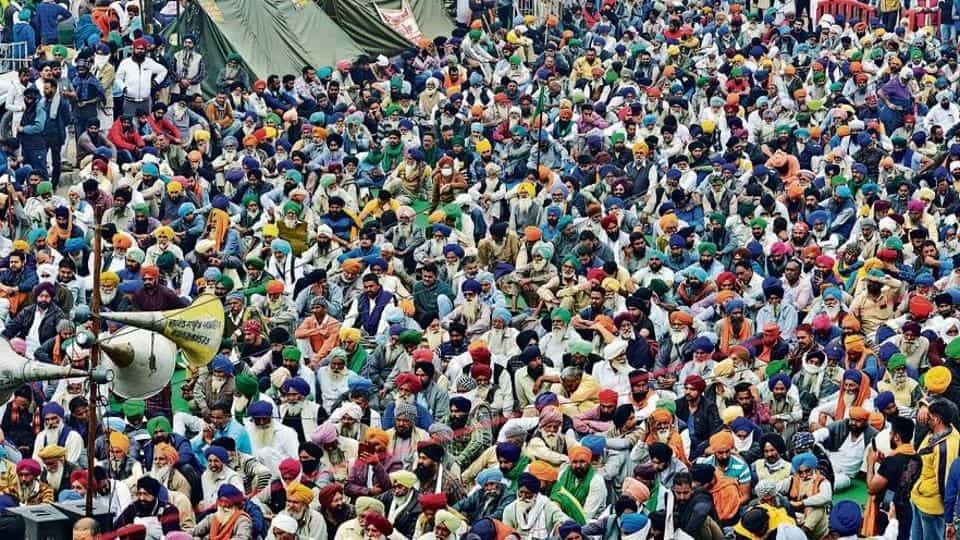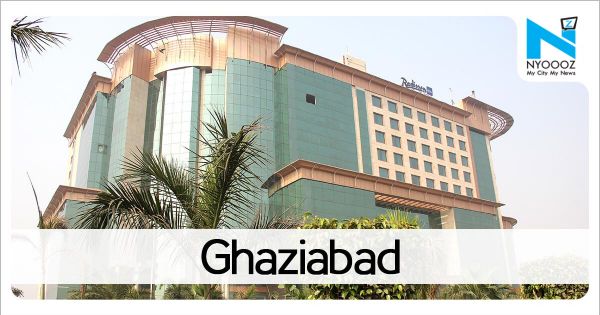
Ghaziabad: At 11 am last Tuesday, Inderjit Singh Khullar loaded his truck with firewood and headed out of his village in central Punjab’s grain bowl of Moga for the Delhi-Haryana border at Singhu. He had with him three other men who made the same 330km trip seven times before in the past 30 days, each time with different loads: Food, water, milk, or blankets.
Ghaziabad: At 11 am last Tuesday, Inderjit Singh Khullar loaded his truck with firewood and headed out of his village in central Punjab’s grain bowl of Moga for the Delhi-Haryana border at Singhu. He had with him three other men who made the same 330km trip seven times before in the past 30 days, each time with different loads: Food, water, milk, or blankets.
They drove through the day, stopping only for short durations in makeshift community kitchens, or langars, set up on the highway linking Punjab to Delhi. All farmers, the four men took turns to drive and fought sleep by talking about the protests against three recently enacted farm laws. “In our village, everyone only talks about the protests. They say it is our final stand, it is do or die,” said the 30-year-old. At 2am, their truck pulled up at the protest site on National Highway 44 that links Srinagar to Kanyakumari. They had driven through Haryana, where last months, groups of farmers clashed violently with security forces, braving water cannons, tear gas and lathicharge en route to Delhi, throwing police barricades into the river and driving their tractor-trolleys over ditches dug on highways.
But the truckers found little resistance on their way. “In the initial days of the protest, we used to be stopped at checkpoints. Now, they have softened their stance and allow us to pass by. They have also understood,” Khullar said. His friend, Gurpreet Singh from Ferozepur district, said almost half his village was at Singhu, and the rest were at home but eagerly following the protest. They get minute-by-minute updates through the many Punjabi accounts on Facebook, Twitter and WhatsApp broadcast that have mushroomed over the past month. “Sometimes they are even better informed than us,” Singh joked.
Back home, the families have formed a system to take turns on work on fields that need sowing, tilling of weeding. If someone’s family members are at Singhu, others are pitching in. “Our political differences have dissolved. This is our united fight,” said Singh. The four men slept in the truck, woke up early on Wednesday and maneuvered through a narrow strip of the highway kept open by farmers for supply vehicles and visitors. As they chatted and unloaded the supplies, people gathered around them for the wood, essential for cooking and bonfires during the chilly December nights. The men stayed on for a few days, checking with people what supplies the protesters are running low on, before leaving again. “We want to stay here but someone also has to work back home on the fields of these farmers and ensure they have all that they need here,” Khullar said, wiping sweat off his brow.
The four men are part of an intricate but informal network of workers who have sustained the month-long protest by farmers at Singhu by replenishing dwindling rations, cooking for thousands, sweeping roads, distributing woolen socks free-of-cost, cleaning toilets, organising security patrols, buying tens of thousands bottled water, and even keeping up morale with displays of community pride or chanting religious hymns.
Together, these groups have helped farmers from Punjab, Haryana and elsewhere in northern India put up a largely united stand in their deadlocked talks with the government to press for the repeal of the three agriculture reform laws. “This is our seva for this cause,” said Khullar.
LIVING ON A HIGHWAY
Protests began in Punjab and Haryana shortly after the government pushed the three laws – Farmers’ Produce Trade and Commerce (Promotion and Facilitation) Bill, 2020, Farmers (Empowerment and Protection) Agreement on Price Assurance and Farm Services Bill, 2020 and Essential Commodities (Amendment) Bill 2020 – through Parliament in September. The laws did away with a network of decades-old, government-controlled agricultural markets, allowed businesses to freely trade farm produce outside the so-called mandi system, permitted private traders to enter the market and laid down new rules for contract farming. But many farm groups rejected the new legislation, saying the reforms left them vulnerable to exploitation by big corporations and eroded the government’s procurement and price support system. The possibility that state-run market yards known as agricultural produce marketing committees (APMCs) – of which there are about 585 in 16 states and two union territories -- could shut down also fuelled anger.
The government has repeatedly assured farmers that market yards will not be abolished, and minimum support prices will continue but farmers have rebuffed the offer. PM Modi has promised that the reforms are for the welfare of farmers.
Driving tractor trolleys and stocked with food, water and diesel, the farmers arrived at Delhi’s borders by November 27 at four spots: Singhu, Tikri, Ghazipur and Chilla. They quickly set up tenements, building a main stage and ancillary platforms, spreading carpets on the highway and opening community kitchens.
But as talks dragged on with the government – negotiations are at an impasse after six rounds – the protesters realised they needed a system to coordinate with families back home for grain and other resources. They converted tractor-trolleys into makeshift homes, using quilts to line the floor and saris to block off separate sleeping spaces for women. Every village set up a committee comprising five to six men for supplying essentials like milk and vegetables. “We fixed a system where only one village arranges for supplies for a day. This way, the responsibilities are divided equally. We have a team back home and they only have to be told what we need. Following this, they coordinate with villagers and deliver the supplies here the next day,” said Lakhwinder Singh, a member of Bharatiya Kisan Union (Siddhupur). He has a team of 300 people from seven villages in Mohali camping with him.
FOOD
One of the most visible part of the protest are the hundreds of cooks making meals for the protesters in tandem. Satyender Kaur is one of them. The 50-year-old woman, along with a group of five women, came from Chandigarh to help the protesters. “How could we sit at home and not feed them?” she asked, kneading dough in a large vessel. Behind her, smoke rose from large kadais as groups of men and women sat around the fire, chopping large mounds of vegetables. Others sorted the line of hungry incoming into neat files, seated them on carpets and served them food in small steel buckets. Large pots of tea boiled nearby.
Such langars are run not just by organisations and Sikh charities but also small groups of women and men. There are at least two dozen such langars on the highway, churning out no less than 6,000 plates of food every day. The mass cooking has even upended gender norms as many men, who never entered the kitchen back home, now helm the process. “We never needed to cook. We would spend our time working on the fields and our wives would provide the meals,” said Kuldeep Singh, a resident of Shaheed Bhagat Singh Nagar district.
It took him 10 days to get the taste right. “Since we have elderly protesters who may have high blood pressure, we use less salt and serve pickles with the food. That too enhances the taste. We try to keep a diverse menu,” he said. The menu ranges from parathas stuffed with paneer, radish or potato, to curries of peas and carrots, and the Punjabi delicacy of sarson-da-saag and makki-di-roti. Large cups of tea, cakes and packaged drinks are offered alongside. In the evening, there are pakodas, snacks, biscuits and local desserts such as pinni, jalebi, and kheer. At night, they serve tall glasses of milk infused with spices and turmeric.
“Farmers send supplies like milk and water to everyone. We often keep an eye out so that they don’t give us extra,” said Lakhwinder Singh. There are no fridges around, so special care is taken for milk. “If the milk gets sour, we make paneer and stuff it in the parathas the next day,” said Gurjant Singh, a resident of Mohali, who has been at Singhu since November 27. The farmers use gas cylinders and wood for cooking the meals, refilling the cylinders every day at a nearby market. An inventory team has also been set up at the Kessel Grand Mall –around four kilometres from the main stage at the protest site.
“Since there are jammers around the area and the network is intermittent here, we have also arranged for 31 walkie-talkies assigned to main volunteers handling security, logistics, stage, and other managerial positions,” said 26-year-old Nirmal Singh Cheema from Jalandhar, who is participating in an agitation for the first time. “My parents had asked me to come back home for my sister’s wedding on Friday but I told them that I could not go back unless the laws are repealed. So I watched her wedding online.”
WATER AND ELECTRICITY
A bigger challenge than food is electricity and water supply. Sukhpreet Sukha Lambar, a former state kabaddi player from Punjab, is among a group of wrestlers and kabaddi players at the Kessel Grand Mall who provide laundry facilities.
“We are in touch with the mall authorities and pay them for using their electricity and water facilities for cooking, cleaning, laundry, and other requirements,” said Lambar. Other farmers drive their tankers to the mall, and use a makeshift water pump to fill it up. Others use water tankers provided by the Delhi government, walk to nearby tube wells or have struck deals with local residents to use the submersible water pumps at local factories and shops. Raghav Chadha, DJB vice-chairman, “Around 25 water tankers carrying 125,000 litres of water have been deputed at the protest site along with 44 personnel to manage the distribution. The tankers have been evenly distributed in the area so that it is accessible to all people and they get filled multiple times during the day.”
Most of the drinking water at the site is bottled and come from farmers and volunteers in Haryana and Punjab. Ravinder Singh, a resident of Karnal, gets up at 6am everyday and drives his mini truck to Singhu with bottled water and vegetables, then spends the day managing the crowd at the langar, before packing up around 5pm and going back home. The source of electricity is local too. The farmers have carried large batteries and use their tractors to power inverters. During the day, some farmers have also set up solar panels on the roof of their tractor-trolleys for charging mobile phones and powering LED bulbs. Organisers said the electricity required to operate the speakers and light on the main stage were sourced from a local resident.
“Since we cannot get an electricity connection, we have got a temporary connection from a local shopkeeper. The electricity is used to operate sound and the LED screen at the stage area along with loudspeakers. We will pay them for the usage,” said Devinder Singh, a member of Bharatiya Kisan Union (Doaba).
But not all residents are supportive of the protests. Anand Singh, a sand supplier and resident of Kundli, has let the farmers use his water pump and godown but is resentful of the losses his shuttered business has suffered. “They came and asked if they could use the motor. How can we refuse if someone needs water? I have made a loss of Rs 3 lakh but there is nothing we can do,” he said.
TOILETS AND SANITATION
By far, the biggest problem facing the farmers is that of sanitation and toilet facilities. The municipal corporations of north Delhi and Sonipat have deployed sanitation staff for sweeping roads and removing garbage, but hundreds of thousands of disposables is being generated as solid waste every day – a big langar easily uses over 20,000 disposable plates a day and 10,000 plastic bottles or cups. The North Delhi Municipal Corporation sanitation staff comes in three shifts of 12 workers each. Around 25 additional workers are deployed for sweeping roads in the morning. Three supervisors of the rank of Sanitary Inspector and Assistant Sanitary Inspector supervise the work, and the sanitary superintendent of Narela zone looking after the work. From Haryana, workers make 10 trips to the nearby dumpyard. Ravi, a sanitation worker employed with Sonipat Nagar Nigam, said, “We are a team of 60 workers deployed at the spot and are divided equally between day and night shifts. Earlier, the job had fixed hours, but now sometimes we end up making 12 spots to the field nearby where we are required to dump the waste.”
But mounds of garbage piled up along the highway underline that this effort is not enough. This has prompted many farmers to start sweeping roads, segregating waste, and emptying waste bins at designated spots. Amanpreet Singh, a young farmer from Dhadday village in Kapurthala district of Punjab, regularly cleans the sludge-soaked road. “A woman slipped and fell here in the morning. Since the drains often get clogged, the water from cleaning utensils and other activities gets accumulated at the spot. So my friends and I asked for spade, broom, and buckets from farmers and got to work,” he said. The Delhi Urban Shelter Improvement Board has set up 300 portable toilets at the spot along with 15 cleaners working round the clock. Several private organisations and Haryana authorities have also set up portable toilets. Yet, it is not enough.
Farmers often relieve themselves in the field or use the shops and homes of locals. “Men can relieve themselves in the portable toilets or toilets of nearby locals, women cannot do the same due to safety and privacy concerns,” said Hardeep Singh, a farmer from Punjab’s Fatehgarh Sahib District, said. “The women in our village want to join the protests but cannot due to the issue around washrooms. So they only stay for a few days.”
WARM CLOTHES AND MEDICINE
The influx of crowds from across the Capital to the site has birthed a vibrant street market where local merchants on tarpaulin sheets hawk their wares ranging from Nehru jackets and sweaters to percussion instruments, earphones and toys. Zameer Ahmad, 40, is one of them. A resident of northeast Delhi’s Bhagirathi Vihar who supplied Nehru jackets to shops in Sonipat, Ahmad decided to come to Singhu after the blockade shut his business. “As these farmers are sleeping in the open, I thought it would be good for business,” he said, adding that 20 jackets priced between Rs 200-300 is sold every day. Other popular items are disposables, plastic sheets, and dry fruits.
With the mercury dipping and many elderly men and women among the farmers, a recent requirement is that of woolens and thermal wear. The farmers have tied up with charitable organisations in Punjab, who often drive down with their cars filled with warm clothes bought at wholesale rates. “We bring 10,000 mufflers, socks, blankets and women’s wear twice a week from Hoshiarpur. We are a group of five people who volunteer on own our. It is our fight too,” said MS Gill, a businessman from Hoshiarpur. Some of the busiest people at the site are the 15 members comprising the so-called ‘IT cell’ of Singhu who coordinate between 30-40 groups and host meetings in a designated room 3-4 kilometers from the main stage before every round of talks with the government. It is a difficult task, explained Harinder Singh, a PhD student from Rajasthan who is a part of the coordinating team.
“We are connected with the farmer groups on their WhatsApp. Throughout the day they send us videos on the farm laws, explaining how this is harmful for the country, and we share this on our social media platforms. In the coming days, we are planning to host Live sessions with agriculture and economy experts on the issues plaguing the farm sector,” he said.
There are also makeshift medical camps every few kilometers where farmers gather round as doctors check their blood pressure, pore over old prescriptions and give out strips of medicines. Dr. Sandeep Kaur, 28, a resident doctor from Jalandhar accompanied four of her colleagues to Singhu. “My relatives and friends have been participating in the agitation since the beginning. Most elderly complain of diabetes, blood pressure, cold, body ache, indigestion, headache, and fever,” she said, while her colleague requested a farmer to not ask for more than four tablets. “We won’t have enough for all paaji,” she added.
Of course, Covid-19 is a constant worry, especially with few wearing masks or maintaining distancing. But they don’t seem worried. “Wahe guru will save us,” said Gurjant Singh.

If You Like This Story, Support NYOOOZ
Your support to NYOOOZ will help us to continue create and publish news for and from smaller cities, which also need equal voice as much as citizens living in bigger cities have through mainstream media organizations.
Stay updated with all the Ghaziabad Latest News headlines here. For more exclusive & live news updates from all around India, stay connected with NYOOOZ.









